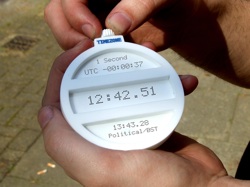A magazine where the digital world meets the real world.
On the web
- Home
- Browse by date
- Browse by topic
- Enter the maze
- Follow our blog
- Follow us on Twitter
- Resources for teachers
- Subscribe
In print
What is cs4fn?
- About us
- Contact us
- Partners
- Privacy and cookies
- Copyright and contributions
- Links to other fun sites
- Complete our questionnaire, give us feedback
Search:
Find your own time zone

Andy Broomfield has given us the secret to figuring out your own personal time zone based on your longitude! Now you can figure out your time zone right down to the second, just like his gadget did.
Step one: find your longitude
First you need find out the longitude of the place you're at. Longitude is the measure of where you are on the globe in an east-west direction (the north-south measurement is called latitude).
The best resource to do this is Google Earth, which will give you a very accurate longitude reading in degrees, minutes and seconds. Just find your location in Google Earth, and when you hover your mouse over it, the latitude and longitude are in the bottom left corner of the window.
There are alternatives to Google Earth online, but they tend to only work for one country rather than the whole world. If you can't use Google Earth, try an internet search for finding longitude in your country.
If you've got a GPS system, you can get it to tell you your longitude as well.
Step two: find your time zone
We'll be finding your time relative to Greenwich Mean Time (GMT or UTC), the base for timekeeping all over the world. If your Longitude is west of 0° you'll be behind GMT, and if it's east then you'll be ahead of it.
Longitude is usually measured in degrees, minutes and seconds. Here's how longitude converts into your personal time zone:
15 degrees of longitude = 1 hour difference; 1 degree longitude = 4 minutes difference.
15 minutes of longitude = 1 minute difference; 1 minute of longitude = 4 seconds difference.
15 seconds of longitude = 1 second difference, 1 second of longitude = 0.066(recurring) seconds difference.
The best way to find your personal time zone is to convert the whole thing into seconds of longitude, then into seconds of time. Do this by adding together:
(degrees x 3600) + (minutes x 60) + (seconds)
You'll get a big number - that's your seconds in longitude. Then if you divide that big number by 15, that's how many seconds your personal time zone is different from GMT. Once you've got that, you can convert it back into hours, minutes and seconds.
An example
Let's find the personal time zone for the President of the United States. The White House is at 77° 2' 11.7" West, so converting this all to seconds of longitude gives:
(degrees x 3600) + (minutes x 60) + (seconds)
= (77 x 3600) + (2 x 60) + (11.7)
= (277,200) + (120) + (11.7)
= 277,331.7
Now we find the time zone difference in seconds of time:
277,331.7 / 15 = 18,488.78 seconds
This means that the President is 18,488.78 seconds behind GMT. Next it's the slightly fiddly business of expanding those seconds back into hours, minutes and seconds. Because time is based on units of 60 rather than 10, dividing hours and minutes into decimals doesn't tell you much. You'll have to use whole numbers and figure out the remainders. Here's how.
If you divide 18,488.78 by 3600 (the number of seconds in an hour), you'll find out how many hours can fit in all of those seconds. The answer is 5, with some left over. 5 hours is 18,000 seconds (because 5 x 3600 = 18,000), so now you're left with 488.78 seconds to deal with. Divide 488.78 by the number of seconds in a minute (60), and you get 8, plus some left over. 8 x 60 is 480, so you've got 8.78 seconds still left.
That means that the president's personal time zone at the White House is 5 hours, 8 minutes and 8.78 seconds behind GMT.
If you're using decimal longitude
Longitude is usually measured in degrees, minutes and seconds, but sometimes, like if you use a GPS reciever, you might get a measurement that just lists your longitude in degrees with a decimal. For example, the cs4fn office is located at 0.042 degrees west.
Figuring out your time zone with a decimal is simpler than with degrees, minutes and seconds. It's just one calculation! Just take your decimal longitude and divide it by 0.004167.
So the local time at the cs4fn office is:
(longitude) / 0.004167
= (0.042) / 0.004167
= 10.079 seconds behind GMT
The only problem with this simple calculation is that it's not as accurate as the one above for degrees, minutes and seconds. Plus, if you get a large number of seconds you'll still have to do the last step from the method above, where you convert seconds back into hours and minutes.
Now you've got your own personal time zone!


